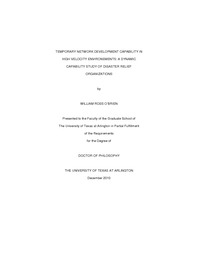
ATTENTION: The works hosted here are being migrated to a new repository that will consolidate resources, improve discoverability, and better show UTA's research impact on the global community. We will update authors as the migration progresses. Please see MavMatrix for more information.
Show simple item record
| dc.contributor.author | O'Brien, William Ross | en_US |
| dc.date.accessioned | 2011-03-03T21:53:39Z | |
| dc.date.available | 2011-03-03T21:53:39Z | |
| dc.date.issued | 2011-03-03 | |
| dc.date.submitted | January 2010 | en_US |
| dc.identifier.other | DISS-10871 | en_US |
| dc.identifier.uri | http://hdl.handle.net/10106/5545 | |
| dc.description.abstract | Organizations involved in crisis relief after a natural disaster face the multifaceted challenge of significantly changing needs of their various stakeholders, limited, ambiguous and even incorrect information, and highly compressed time limitations. Yet the performance of these organization in these high velocity environments is critical for the lives and welfare of disaster victims. This research suggests that relief organizations that possess a dynamic capability to proactively form temporary networks are better suited to respond to crises. Further, the study identifies antecedents of such a temporary network development capability (TNDC), specifically prior network experience, swift trust, prior crisis experience, a generalist strategy, organizational humility, minimal political behavior, reputation and legitimacy. In addition, the study demonstrates the relationship between TNDC and organizational performance, along with the moderating impact of factors in the external environment and internal resource availability on this direct relationship. Building on the foundation of extant literature in the areas of interorganizational networks and dynamic capabilities, the study begins with a qualitative analysis to develop a theory to support TNDC. Semi-structured interviews were conducted with relief organizations in the US Gulf Coast after Hurricane Katrina and in Banda Aceh, Indonesia after the Asian Tsunami. Interview responses were coded to develop a model which could be further analyzed. From the extant literature and results of the qualitative study, a survey instrument was developed to measure the relationship between various antecedent factors and TNDC, as well as between TNDC and organizational performance. The survey was pilot tested to ensure reliability and validity and then submitted to relief organizations involved in disaster relief activities to evaluate the nature of the hypothesized relationships. | en_US |
| dc.description.sponsorship | Perez-nordtvedt, Liliana | en_US |
| dc.language.iso | en | en_US |
| dc.publisher | Business Administration | en_US |
| dc.title | Temporary Network Development Capability In High Velocity Environements: A Dynamic Capability Study Of Disaster Relief Organizations | en_US |
| dc.type | Ph.D. | en_US |
| dc.contributor.committeeChair | Perez-Nordtvedt, Liliana | en_US |
| dc.degree.department | Business Administration | en_US |
| dc.degree.discipline | Business Administration | en_US |
| dc.degree.grantor | University of Texas at Arlington | en_US |
| dc.degree.level | doctoral | en_US |
| dc.degree.name | Ph.D. | en_US |
Files in this item
- Name:
- OBrien_uta_2502D_10871.pdf
- Size:
- 1.190Mb
- Format:
- PDF
This item appears in the following Collection(s)
Show simple item record


